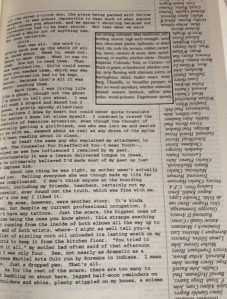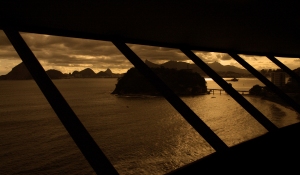This post may seem like a wild, rambling piece of text.
It’s about stars, hyperlinking thoughts, working in a space, using new frames and creating new stories.
It’s about working as a teacher trainer (does this actually exist?) or, as I prefer to refer to it, as someone who guides teacher development, who runs workshops and sessions in which the main idea is to stimulate critical reflection.
This may be sort of a “work in progress” blog post: the work in question being my own attempt to bring together several ideas into a semi-coherent flow of thought. But I promise, I’ll try and make a point at the end of this all (that is if you bear with me until the end).
Last year, in November, I wrote the following in my Facebook page:
When we lie down to look up at the stars in the sky it takes some time for our eyes to adjust to the darkness.
But then the intensity of some stars draws our attention.
Our eyes flit from one bright star to the next and so we capture the scene in its entirety.
Part of the comfort in the unexpectedness of all this stargazing is the knowledge that we know a star will shine bright, we just don’t know which one, where and when.
Fernando Guarany and I’ve been working together over the last few weeks on a workshop session.
A couple of hours of chatting,
listening to each other,
exchanging opinions, expressing pet hates,
listening to others,
reading,
creating frameworks, and then re-creating them,
word-driven ideas,
ideas which hyperlink organically,
ideas that shine in their own space.
This text emerged as a reflection on the opportunity I had of working alongside a colleague and friend, Fernando Guarany, on a joint presentation about “Teaching Unplugged”. The text was written and posted before we actually presented. It was a reflection on the process of how we built up our session. One of the things we both had been thinking about was how to avoid being overly linear in the presentation. Would there be a power point presentation or not? How would we move from one point to the next? How could we be didactic whilst at the same time not stuck to a rigid format? So, my association of our work process with stargazing was exactly that…we knew something would shine and we would be able to hold on to it.
What we weren’t aware of before we presented was how true this would all be. How far having a rough structure (a framework if you will), a great deal of discussion and a shared understanding of things would really allow us to deal with the emergent needs of the group? We ran most of the session on a mutual understanding that one of us would say something when it felt right to say something, when we just looked at one another and knew it was time to give up the space we had momentarily taken and pass it on to the other. And it worked. Yes, we did have a power point presentation in the end, with a few slides designed to be shown as a starting point, but most of them were there to scaffold key concepts after they arose as a result of participants’ questions.
What this brought home to me was how immensely enriching a truly collaborative, interactionist, dialogic, non-scripted, on-the-spot learning/teaching experience can be for all who are there – presenters and participants.
Yet what it also taught me was that, for each person in the room that day, the experience was a different one. (I also suspect that Fernando and I may have interpreted reactions differently as well.) What each person gleaned from the session was different. Reactions and levels of acceptance were quite varied. There wasn’t a homogeneous linearity as to how the session was understood. Yet I don’t think that really worried us: we wanted to raise issues, provoke questions, draw out reactions and we would deal with whatever emerged from participants. That was how we attempted to piece the ideas together.

The degree of non-linearity in the session may have confused some people, who expected a more contained and organised event, with a neat beginning, middle and end, just like a fairy story, which begins with “Once upon a time…”, prepares us for a “Then…” part in the middle and ends with “…and they lived happily ever after”. The “organic hyperlinking” which took place may have been off-putting for some. It’s a bit like reading a book which has footnotes and footnotes on the footnotes. Then all of a sudden, the footnote becomes the driving force of the narrative and takes over (read Danielewski’s book and you’ll understand what it means to have the narrative ambushed by the footnote).
Yet, if we think of it, isn’t this the most natural of processes? Isn’t this what happens when we chat with friends? The conversation flows and merges, from one topic to the next, and then we go, “Oh, by the way, have you heard…” and we don’t hear the end of what was being said and are all ears to what is now going to be said. The focus has shifted, a new star has shone brighter and we choose to gaze onto something else, which promises to be brighter.
Another thing which struck me about the session was the question of space. Space and time. Yes, we had a time limit and that limited the space we had. But isn’t space a question of what you want to fill it with? What if we leave a bit of space to see what emerges?

The format and the pace of the session allowed for the creation of spaces for interaction. Dialogue and the building of understanding can only happen when there is space for that to happen. The thing about space though, a bit like silence, is that it can be worrying and scary. We sort of ask ourselves, “What if the space isn’t filled?”, “What if it just remains there, empty?” or “What if there is a a rush to fill the space up?”
In a fascinating talk in a 5×15 event in London in 2011, writer Mark Haddon said,
“And I sometimes think that the writer’s job is just to create the gaps that the reader can then fill.”
Yes, I think Haddon is right. Writer Safran Foer took this to an easthetic and literary extreme in his remix novel “Tree of Codes” in which empty spaces speak loud and clear. The reader is forced to read between the lines, literally.
Yes, by leaving spaces, creating gaps, something is bound to arise. We jump to fill spaces up, especially in today’s world in which we fear the lack of communication, the lack of contact, the emptiness of silence and space. The space I don’t grab is the space someone else will claim, sooner or later. Yet, how truly comfortable are we with empty spaces? Do we really need to plan out all the moves? Surely teaching is about the process? Surely working in the more specific area of teacher development: now that really is about space and time. And if we agree that our focus is on the process, well then I need space to allow for interaction, exchange and collaboration.
Space is a very useful learning resource. All of us working in the field of ELT are actually quite familar with this. After all, what is an information-gap activity but the creation of a false gap which needs to be filled? These are mini-negotiated interactions in space. Isn’t that where the learning takes place? Isn’t the classroom about creating microcosms of space-driven learning? Don’t we need to try a create the same microcosms when dealing with teacher development?
It is a bit like the way the late Brazilian architect Oscar Niemeyer used the buildings to frame the space around them. By framing spaces through architecture a new view could be seen or the same view seen from a different perspective. Just by changing the perspective, I am given the chance to see what I was unable to see before, or what I was trying not to see before. The frames we create alter the dynamics of the (inter)action.
So, I said at the start that this was rambling with a purpose, and so it is. But just before I conclude, you’ll permit me another brief sidestep.
In his autobiographical book “Beside Myself”, actor Antony Sher recounts the episode in which he went for an audition for the Liverpool Everyman company, under the direction of Alan Dossor and this is what happened immediately after the audition. Alan Dossor speaking to Sher:
‘Your watch flew off during the speech.’
‘Yes,’ I mutter.
‘You ignored it.’
‘Yes,’ I say more confidently.
‘You shouldn’t’ve.’
I hesitate now. ‘But I didn’t want it to throw me.’
‘Why not? It happened. It was throwing. It threw me – it should’ve thrown you – you should’ve used it. Things don’t always go according to plan on stage. They shouldn’t. That’s dead theatre, man, that’s fucking dead theatre.’
Sher actually got the job at the Everyman, but his great doubt was whether he would actually fit in. He came from a very structured, carefully rehearsed, non-spontaneous acting school background. Would he be able to grow professionally and develop as an actor in a space in which being thrown by your watch flying off was a rich learning opportunity?
So, now we come to the conclusion, where all the loose ends are tied, or rather, where we can start to connect up the dots, allowing for multiple readings and interpretations. And here’s mine.
Some of us are in the ELT field because an opportunity came up, we liked the idea of teaching and we specialiased in our field. Some of us have always dreamt of being teachers and are seeking to fulfill our dreams. Whatever led us to the ELT scene, the thing is that being in the classroom or running TD sessions day in and day out is a challenging situtation.
Challenging in so many different ways. Challenging because we may be working with a particularly difficult group, or a different age range of learners, a new level of language learners, a new in-service group of teachers or very-experienced peers who need to look at new apporaches to the ELT classroom. And for those of us who have been in the ELT field for years on end, what else is there for us to learn?
Oh, there is so much more to learn. But I would argue that the learning frames change, just as when we look through a window in a Niemeyer building.
By holding up a new frame, by selecting an out-of-the-ordinary frame we see things differently. We are thrown. We are looking out into that sky and suddenly a new star shines bright, in a section of the sky we had barely looked at before.
This is supposed to throw us.
This is a “live” teaching situation.
It is raw and vivid.
It stops us in our tracks.
This new perspective puts everything we have done so far into question.
It makes us look at things more reflectively and listen to new voices.
It forces us to use the space around us more creatively or even may help us think: wow, there is a space here I hadn’t noticed before.
It throws down the gauntlet.
It can make us exceedingly frustrated at times as well. After all, things don’t always go as planned.
It makes us try out new ideas, make new hyperlinks, understand how ideas and, most importantly of all, how people fit into spaces.
One of my favourite theatre directors, Phelim McDermott, said the following about the process of staging the new Philip Glass opera alongside choreographer Ben Wright:
“It’s really only when you get to see bodies in the space that you get a connection between these ideas that have been in your imagination and what’s tangible.”
It is through collaboration, interaction and dialogue with “bodies” that inhabit the “spaces” that we drive our own learning forward and that I, working with teacher development, have the chance to foster some kind of reflection.
Yes, I think that out of this verbose rambling, this is what I really believe in.
And then it’s about watching.
Watching ideas and people shine in their own spaces and constellations, as it were.
What could be better than this?



thank you for this, Valeria.
Hi Valeria,
What a mind-blowing post, in so many ways…. It resonates in so many points to my own beliefs… But you put it in such a powerful, poetic way (love the quote Giselle selected… I had chosen that myself, go figure!). But I truly believe in watching, watching people and ideas shine in their own spaces.
Brilliant.
I’ve just been thrown by your text. Thank you.
Hi Flavio,
Thanks for your kind words.
Valéria
“The more space and emptiness you can create in yourself, then you can let the rest of the world come in and fill you up.”
Jeff Bridges
I think it´s high time that teachers, ELT or not, understood that the transfer of control in the classroom is profitable for all those involved. Being open enough to leave space for your student and the formulation of ideas/language/events that might arise from that space is no easy task, but it proves to be heavenly rewarding. Thank you for your post…lots to think about =)
Hi Giselle,
Love the Jeff Bridges quote. Yes, you’re right, it is about letting go…or rather, knowing when to let go.
Thanks,
Valéria